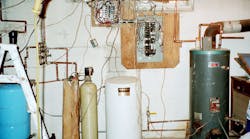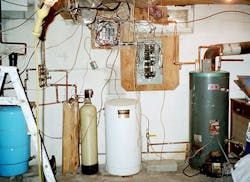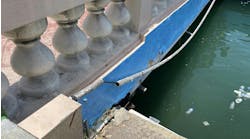How well do you know the Code? Think you can spot violations the original installer either ignored or couldn't identify? Here's your chance to moonlight as an electrical inspector and second-guess someone else's work from the safety of your living room or office. It's your turn to identify the violation.
Hint: A shocking situation
Find the Answer
Warren Tinker, a retired electrician, was kind enough to share this photo with us. In his words, “The owner wanted me to put the covers on. This house was sold to him as having a 200A service. Obviously they tried to (and accomplished) doubling up on the main breaker lugs with the meter still plugged in. The power came in to the panel on the left and they mounted the second panel under a leaky window. The next real noticeable issue was the propane gas line running near the top of the panel – then the water line from the water heater going over the top of the panel. The plastic outlet box, all the unsecured wiring, the water pressure switch has no box connector, the panel on the right, under the window, has one leg of the 100A breaker jumpered to the 30A breaker next to it.”
Well, the most obvious Code violation would be the lack of covers for the panelboards. Without covers to guard and accidental contact with live parts you have a severe shock and fire hazard. This also violates the requirements of Sec. 110.27(A).
But let’s be honest. This is most likely a candidate for a complete “do over”!





